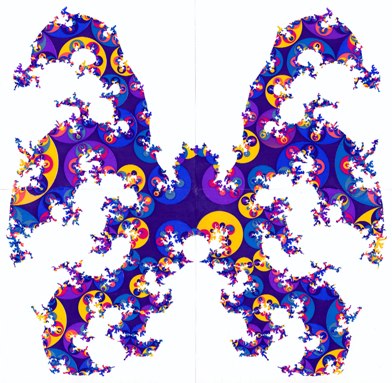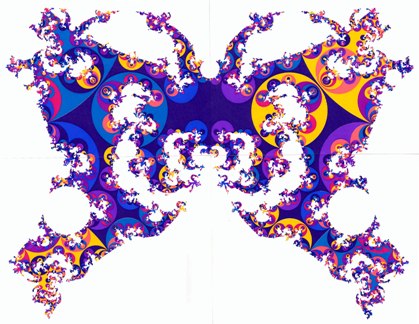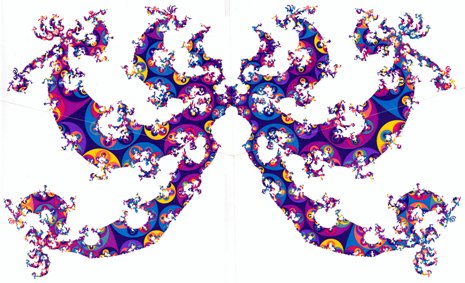Tomaschitz, R. (1997). Chaos and topological evolution in cosmology, International Journal of Bifurcation and Chaos 7, 1847-1853, DOI: 10.1142/S0218127497001412
Abstract (WorldSciNet, CDS, SAO/NASA ADS, Zbl 0907.58066)
An elementary account on the chaoticity of galactic world-lines in an open universe is given. A new type of cosmic evolution by global metrical deformations, unpredicted by Einstein's equations, is pointed out. Physical effects of this evolution are backscattering of electromagnetic fields and particle creation in quantum fields. We review in an untechnical way how global metrical deformations of the open and multiply connected spacelike slices induce angular fluctuations in the temperature of the cosmic microwave background radiation.
Zbl
0907.58066
Tomaschitz, Roman
Chaos and topological evolution in cosmology
[J] Int.
J. Bifurcation Chaos Appl. Sci. Eng. 7, No.8, 1847-1853
(1997). ISSN 0218-1274
MSC
2000:
*37N99
Applications of dynamical systems
83F05 Relativistic cosmology
37D45 Strange attractors, chaotic dynamics
Keywords: cosmology; chaoticity; galactic worldlines; cosmic evolution
|
Title: |
|
Chaos and topological evolution in cosmology. |
|
Authors: |
|
Tomaschitz, R. |
|
Publication: |
|
Int. J. Bifurcation Chaos Appl. Sci. Eng., Vol. 7, No. 8, p. 1847 - 1853 |
|
Publication Date: |
|
08/1997 |
|
Origin: |
|
|
|
ARI Keywords: |
|
Cosmology: Chaos, Cosmic Microwave Background: Fluctuations |
|
Bibliographic Code: |
|

Fig. 1(a) full size image

Fig. 1(b) full size image

Fig. 1(c) full size image
Fig. 1. (a)–(c) The horizon at infinity of the Poincaré half-space H3, the universal covering space of the spacelike three-sections of the extended RW cosmology. A spacelike slice (F,Γ) is realized in H3 as a polyhedron F with face-identification. The face-pairing transformations generate a discrete group Γ which gives, if applied to the polyhedron, a tessellation Γ(F) of H3 with polyhedral images. This tessellation induces by continuity also a tiling on the boundary of H3, which is depicted here (for three different slices), and which can easily be extended to three dimensions; the complete tiling of H3 is simply obtained by placing hemispheres onto the circular arcs. This polyhedral tiling of hyperbolic space H3 is the covering space construction for the RW geometry. So these two-dimensional tilings constitute a completely quantitative characterization of the three-dimensional spacelike slices.
The qualitative structure of the fractal limit set Λ(Γ) depends on the topology of the three-slices, which is in turn determined by the covering group. For quasi-Fuchsian groups [Maskit, 1986] like those seen here, the limit set is a Jordan curve. The three-space fibers over an open interval, with Riemann surfaces (g = 49) as fibers. The colors label generations in the tiling procedure, the algorithm is given in [Tomaschitz, 1989]. The tilings correspond to three-slices which are non-isometric, but have the same topology and curvature. They are three snapshots in a time-parametrized sequence of continuous global deformations of the three-space, realized here as deformations of the polyhedron F and the covering group Γ.
The chaotic trajectories have covering trajectories with initial and terminal points in Λ(Γ). If the end points are not in Λ(Γ) but close to it, then the trajectory is regular, but it is shadowed by chaotic trajectories over a long period. The convex hull of Λ(Γ) is the intersection of all hyperbolic half-spaces which contain Λ(Γ). Projected into (F,Γ) by means of the universal covering projection, it constitutes the chaotic center of the three-space. Here again, the tilings on the boundary of H3 are the key for the explicit construction of this nucleus of the open three-space by methods of elementary geometry [Tomaschitz 1994a, 1994b].
description: Roman Tomaschitz (1997) Chaos and topological evolution in cosmology, International Journal of Bifurcation and Chaos 7, 1847.
Keywords: open Robertson–Walker cosmology, multiply connected hyperbolic 3-space, open hyperbolic 3-manifolds, constant negative curvature, chaoticity of galactic world lines, topological backscattering of electromagnetic fields, particle production in quantum fields by global metrical deformations, temperature anisotropy of the microwave background radiation, chaotic nucleus of the open 3-space, universal covering space of the multiply connected spacelike slices, Poincaré half-space, polyhedral tessellation of hyperbolic space, limit sets of Kleinian groups, quasi-Fuchsian covering groups, fibered hyperbolic 3-manifolds, covering projection, hyperbolic convex hull of a fractal limit set, chaotic trajectories, mixing, shadowing
download full-text article (PDF)